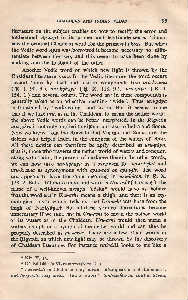Page 743 - Lokmanya Tilak Samagra (khand 2)
P. 743
CHALDEAN AND INDIAN VEDAS 95
literature on the subject enables us now to rectify the error and
understand Apsu1it in its proper and legitimate sense. Tiamat
was the original Chaldean word for the primeval abyss. But when
the Vedic word Apsu was. borrowed it became necessary to diffe-
rentiate between the two, and this seems to have been done by
making one the husband of the other.
Another Vedic word on which new light is thrown by the
Chaldeanliterature is uru. In the Vedic literature the word occurs
several times by itself and also in compounds like uru-krama
( ~. I. 90. 9 ), uru-k~haya ( ~· X. 118. 9 ), uru-gdya ( ~. I.
154. 1) and several others. The word uru in these compounds is
generally taken as an adjective meaning 'wide'. Thus uru-gdya
is translated by ' wide-going ' and so on. But it seems to me
that if we take uru, as in the Chaldean, to mean the nether world,
the above Vedic words can be better interpreted. In the ~igveda
uru-gdya is not only applied to Vil!!h'!lu but also to Indra and Soma.
Now we know from the ~igveda that ViiJh'!lu and Soma are the
deities who helped Indra in the conquest of the waters of Apsu.
All these deities can therefore be aptly described as uru-gdya,
that is, those who traverse the nether world of waters and conquer,
along with Indra, the powers of darkness therein. In other words,
we can now take uru-k~haya as a synonym for apsu-k~hit and
uru-krama as synonymous with apsu-sad or apsu-jit. The word
uru appears to have the same meaning in uru-lokam in ~. X.
128. 2. But a still more important word is Uru-ash£ ( Urvashi ), the
name of a well-known nymph. Yaska* would have us believe
that the word uru in Uru-ash£ means a thigh, and there is an ety-
mological myth which tells us that Uru-ash£ was born from the
*high of N:..raya'!la.t But all these strange derivations become
unnecessary if we take uru in Uru-ash£ to mean the nether world
or its waters as in the Chaldean. Uru-ash£ would then mean a
watery nymph or a nymph of the nether world and can thus be
properly described as ap-saras. There are a few other words in
the ~igveda on which new light may be thrown by the discovery
of Chaldean literature. For instance sin£vdlit looks to me like a
• Nir. V. 13.
t Cf. Ka.lidasa's Vikramorva,h!ya, I. 3·
t Sit~ buNmli in Chaldean may mean 'disappearance of the moon',
and tut·-parattu may mean 'son of water'. Sindhumtftarau, sons of ocean,

